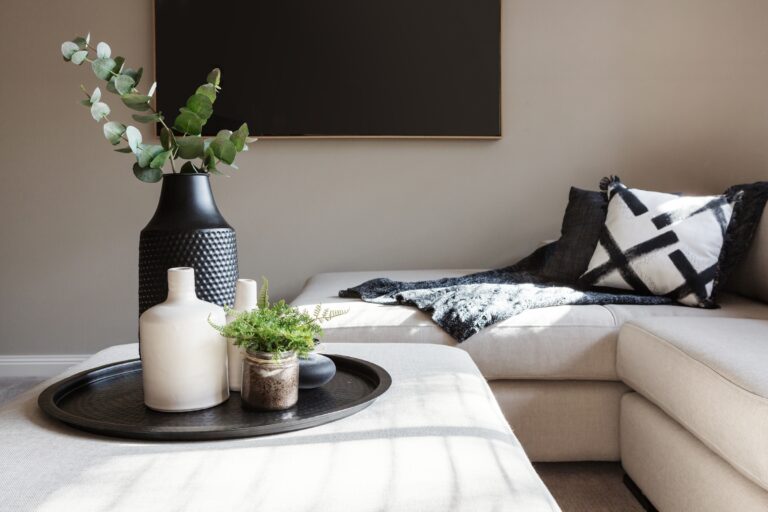Passive income is a buzzword in creative industries, and interior design is no exception. As busy professionals, generating income with no ongoing effort may sound too good to be true. But with the right strategies and a little creativity, interior designers can build sustainable passive income streams that multiply earnings without interfering with active projects.
This post will help you clear up common misconceptions about passive income, familiarize yourself with different revenue streams, refine your pricing strategies, and more.
Table of Contents
Can interior designers achieve passive income?
Short answer? Yes. While interior design traditionally works on a service-based model, today’s landscape offers professionals the opportunity to package their expertise into scalable assets that can generate revenue long after the initial work is complete. It’s a supplement, not a replacement, to your core design practice, but when done well, it can make a large, lasting financial impact.
So, how exactly does passive income for interior designers work? It involves creating a valuable resource or tool once and then earning from that investment repeatedly over time.
Beyond the financial gains, evergreen digital products also contribute to brand growth, helping you reach new audiences and establishing your authority in the industry.
6 passive income sources for interior designers
Here are six passive income sources tailored to interior designers, each with potential for long-term growth and scalability:
1. Online courses and workshops
Designers with a strong niche or area of expertise can create and sell online courses. Platforms like Articulate, Skillshare, and Coursera make it easy to distribute content. Once the course is created, ongoing income depends on marketing and enrollment. As you plan your course, consider your core strengths, such as marketing, project management, client onboarding, or another specialty. You could also create an introductory class on your signature style, such as Scandinavian Design 101.
2. E-Books and digital guides
Well-structured digital products such as e-books, style guides, and checklists can be sold through your website or marketplaces like Etsy. Topics can range from “How to Plan a Home Office” to “Lighting Design for Small Spaces.”
3. Affiliate marketing
If you have a blog, newsletter, or social media following, affiliate marketing can be a steady source of passive income. Recommend furniture and decor products you genuinely adore, and earn commissions from purchases made through your links.
4. Design templates and mood boards
Selling branded design templates, mood board kits, and presentation slide decks can appeal to other designers and DIY homeowners. These assets are especially effective if you’re known for a unique aesthetic. Tools like DesignFiles streamline this process with an intuitive moodboard editor, access to over 500K products, and automatic branded tear sheets. With just a few clicks, you can create high-quality deliverables that appeal to other designers and DIY clients alike.
5. Stock photography and 3D renderings
If you produce high-quality interior photography or 3D visualizations, consider selling them as stock content. Websites like Adobe Stock, Shutterstock, and Creative Market are great distribution platforms for interior design images.
6. Licensed designs/artwork
If you create original artwork, such as framed pieces or wallpaper designs, licensing them to manufacturers or retailers can bring in ongoing royalties. This model allows you to reach wider markets without managing production yourself.
Wondering how to price passive income work in interior design? Approach it the same way you would pricing service packages. Buyers expect clear, fixed rates when working with digital products or pre-made deliverables. You deserve fair compensation for the time and expertise you invest, but since clients aren’t receiving fully customized, hands-on service, the pricing needs to remain accessible and straightforward.
Passive income myths and misconceptions
When exploring passive income, it’s essential to separate fact from fiction. Here are some common misconceptions among interior designers:
Myth 1: “Passive income requires no effort.”
Reality: While passive income reduces ongoing involvement, it still requires significant upfront work, especially in the creation stage. It will also likely require consistent marketing efforts moving forward.
Myth 2: “You need a huge following to earn passive income.”
Reality: A large audience helps, but a targeted audience is even more important. Interior designers with niche expertise can monetize all sizes of communities effectively.
Myth 3: “Passive income replaces your core business.”
Reality: For most interior designers, passive income works best as a supplementary revenue stream. It should enhance your core practice, not overshadow it.
Myth 4: “Only tech-savvy designers can do this.”
Reality: Many platforms today are user-friendly and tailored to the non-technical type. With a modest investment in learning, any motivated designer can build digital products.
Myth 5: “I need to be great at sales.”
Reality: Selling digital products takes fewer sales skills than traditional interior design packages. There will be no discovery calls, consultations, or budget negotiations to worry about.
5 ways to make your passive income sources more successful
Generating passive income is one thing—maximizing it is another. Here are five strategic ways to ensure your passive income streams are not only active but thriving:
1. Leverage your existing brand and network
Your credibility as a professional designer is your strongest asset. Use your portfolio, testimonials, and client results to add weight to your offerings. Promote your products or courses through your website, email newsletter, and social media profiles.
2. Automate where possible
Use automation tools to reduce hands-on management. Email sequences, payment systems, and course platforms can all be set to run with minimal oversight.
3. Focus on evergreen content
Create products that aren’t time-sensitive or tied to trends that will soon fade. For instance, a guide to open-plan living will have a longer shelf life than a style guide based on picking the perfect gray walls in the 2010s.
4. Optimize for SEO and discoverability
Whether you’re selling templates or courses, you’ll need to put in some effort to make sure they’re discoverable. Use relevant keywords, clear descriptions, and quality visuals. Consider writing blog posts or recording YouTube content that leads viewers to your deliverable.
5. Test, measure, and iterate
Passive income is not exactly a “set-it-and-forget-it” endeavor. Track what sells, what doesn’t, and where your traffic comes from. Use that insight to refine your offerings, adjust pricing, or pivot entirely if needed.
Whether you’re looking to reduce dependence on project-based income, scale your brand’s impact, or future-proof your career, now is a great time to explore what passive income can do for you.
Looking for more ways to diversify your income? Our interior design salary guide shares strategies for increasing project profitability, forecasting expenses, and attracting new clients. And our guide to product markups covers how pricing furniture and decor strategically can boost your take-home pay.
Ready to build your passive income empire? DesignFiles offers everything you need—from creating stunning digital deliverables to managing client interactions and payments.


